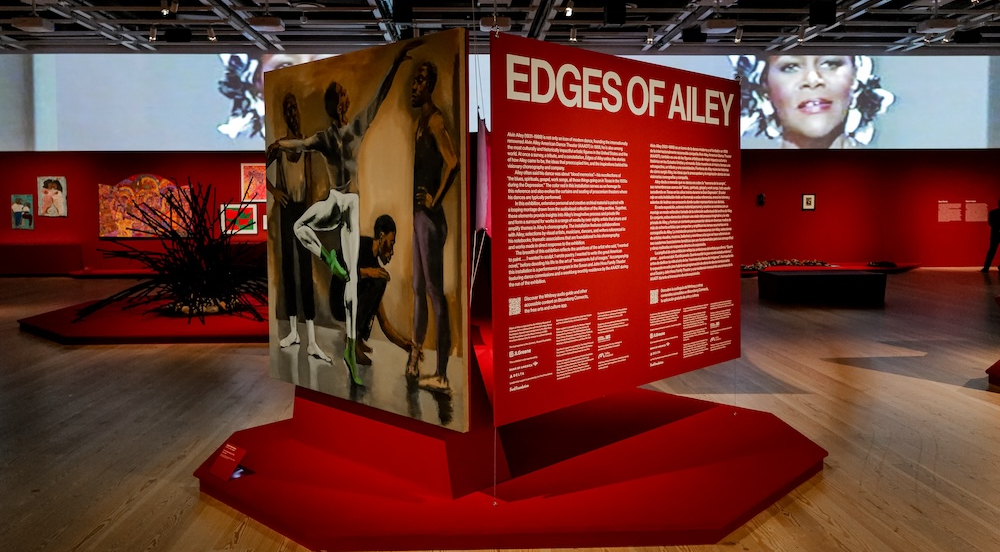With powerful gospel, blues and jazz surrounded by historic dance imagery, the Whitney Museum of American Art’s newest exhibit, “Edges of Ailey,” provides an immersive experience showcasing the life of trailblazing dancer and choreographer Alvin Ailey. Told through a mixed-media approach, the exhibit includes a multi-screen film presentation, visual arts, performances and archived materials from Ailey’s life.
Alvin Ailey, born in 1931 in Rogers, Texas, is celebrated as a revolutionary modern dancer and choreographer who transformed the dance world through his visionary artistry and activism. At 22, Ailey began to train under Lester Horton, and within the year, Ailey became the artistic director and choreographer for the distinguished Horton Dance Company. Shortly afterward, Ailey began to perform for many Broadway shows, building his reputation and dance technique.
In 1958, after his Broadway career, Ailey opened the Alvin Ailey American Dance Theater, which remains a successful modern dance company in New York City today. The company continues to dedicate its work to illuminating African-American culture through modern, ballet and West African dance. Within Ailey’s activism in Black liberation, the exhibit displays a quote of his: “Look how beautiful we are, look how wonderful we are as Black people. Look what’s happened to us in all these years despite our problems, despite being brought here as slaves, look what has grown in us.”
In the 18,000-square-foot fifth-floor galleries, the Whitney Museum invites guests to explore and absorb Ailey’s legacy. Upon stepping into the space, it is impossible to miss the video created by filmmakers Josh Begley and Kya Lou and curated by Adrienne Edwards. This multi-screen video installation captures the essence of the exhibit, showcasing Ailey’s works, inspirations and even his own voice. It captivates viewers—some sit on benches to watch the entire sequence, while others let it serve as an ambiance to the rest of the exhibit.
The exhibit’s open design, divided into 10 distinct sections, invites guests to explore Ailey’s life in their own way. Visitors might be drawn to the large modern works, immersive audio experiences or even a simple painting. In the section dedicated to Ailey’s influences, museumgoers can view archives of his personal notes. His theater, literature and music studies are represented through works by Duke Ellington, literature by Tennessee Williams and an extensive collection of video inspirations.
Embracing Ailey’s past, the Southern Imagery section defines his roots in rural Texas. As a child, Ailey witnessed his mother working in cotton fields and as a domestic in white homes to support their family. “Edges of Ailey” chooses to exhibit the poverty, racism and perseverance he faced through paintings detailing the experiences that formed him.
Scarred from the racism he and his mother endured daily, Ailey found solace in the church. Ailey’s roots in the gospel church are consistently depicted through his choreography. He saw Black gospel churches’ baptisms and overwhelming spirituality to represent the human spirit. Though the museum displays specific paintings depicting Black spirituality, references to Black spirituality may be found throughout any section, as this passion influenced Ailey to go on to create some of his most famous works. Ailey’s best-known work, “Revelations,” is an Alvin Ailey American Dance Theater piece performed for over 23 million people in 71 countries. This piece has unveiled Black spirituality to a broader audience than ever thought possible; with performances at presidential inaugurations and the Olympics, Ailey proved that dance may communicate beyond faith.
The remaining sections continue to weave a rich narrative of Ailey’s impact and legacy, covering themes such as migration, liberation and the vital role of Black women in his life and work. Separately from the exhibit, visitors looking for a fully comprehensive view of Ailey’s works may attend performances by the Alvin Ailey American Dance Theater. The Alvin Ailey American Dance Theater is performing week-long residencies at the Whitney Museum, displaying both restagings of Ailey’s choreography and new works in honor of his life.
This exhibition is designed to be accessible to all. Descriptions are available in English and Spanish, with an additional option for verbal descriptions via a listening device. Students can enjoy discounted tickets for just $24, and the Museum offers free admission to everyone on Friday evenings from 5–10 pm and on the second Sunday of each month, including access to the “Edges of Ailey” exhibit.
“Edges of Ailey” provides more than just a traditional museum exhibit of a renowned choreographer—it demonstrates Ailey’s enduring influence on art, culture and the fight for equality. Proven by his dance works, one does not need to be a dancer to connect with Ailey. The human spirit displayed by Ailey’s works invokes passion in people on its own. At the Whitney Museum until Feb. 9, this tribute will ensure that Ailey’s work will continue to inspire audiences to celebrate, connect and feel together.





